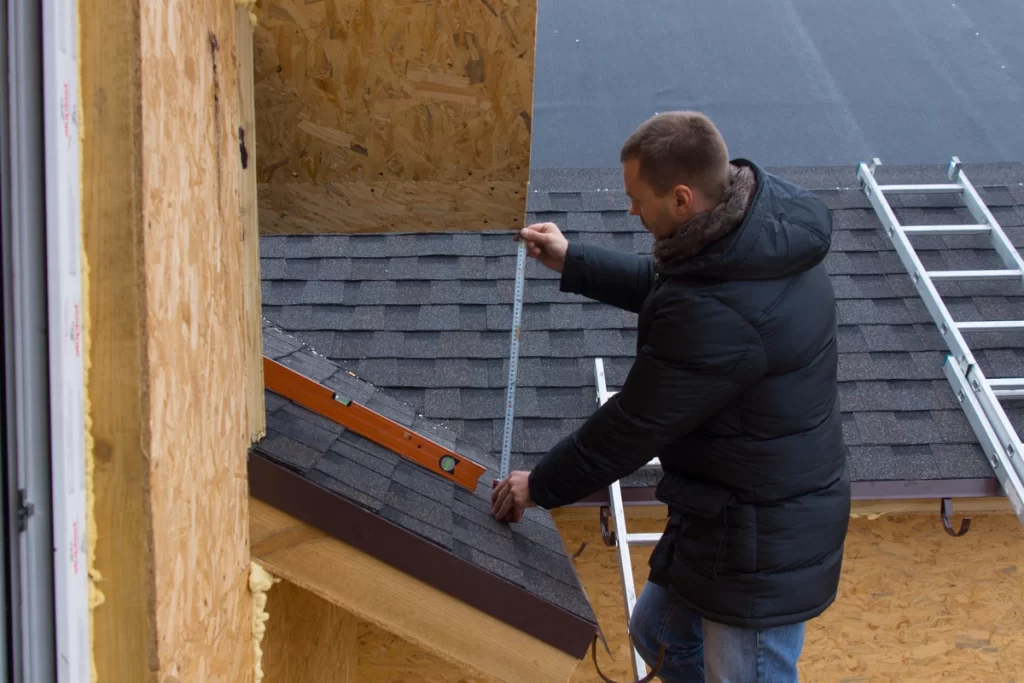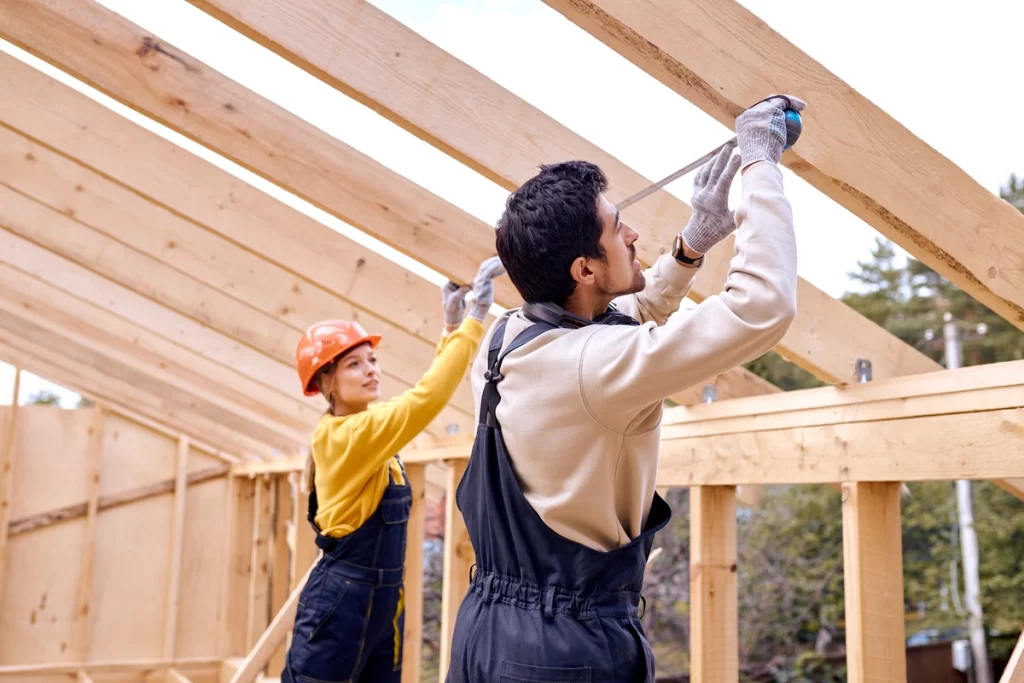Need to know your roof’s dimensions? And not exactly sure how to go about it?
If you’re not sure how to measure your roof, you certainly are not alone. After all, it’s not a skill that comes in handy very often. However, when you do need it, it’s important that you know how to measure it properly, whether you’re:
- Planning a roofing project
- Considering solar panel installation
- Curious about the dimensions of your roof
In this comprehensive guide, we’ll walk you through the why, how, and when of measuring your roof, as well as why it’s often best left to the professionals. Remember to get your roof inspected at the first sign of damages, but for now—
Keep reading to learn how to measure a roof properly.
Why Measure Your Roof?

There are several reasons why you might need to measure your roof:
1. Roofing Projects:
If you’re planning to repair, replace, or upgrade your roof, you’ll need precise measurements to estimate materials, costs, and labor. Accurate measurements are crucial to avoid underestimating or overestimating your project’s scope.
2. Solar Panel Installation:
Solar panels can be a wise investment for your home, but they require an accurate assessment of your roof’s dimensions and orientation to maximize energy production. A precise measurement is essential to determine the number of panels you can install and their optimal placement.
3. Insurance Claims:
In the unfortunate event of roof damage due to a storm, hail, or other natural disasters, your insurance company may require accurate measurements to process your claim. Providing precise measurements can help ensure you receive fair compensation for repairs or replacements.
4. Property Assessment:
If you’re buying or selling a home, knowing the exact dimensions of the roof can be valuable information. It can influence the property’s overall value and help potential buyers or sellers make informed decisions.
5. DIY Projects:
For ambitious DIY enthusiasts, knowing your roof’s measurements can be essential when planning projects like building a rooftop deck, adding a skylight, or constructing a dormer. Accurate measurements are crucial to ensure that these projects are structurally sound.
How to Properly Measure Your Roof
Measuring your roof may sound like a daunting task, but with the right tools and methods, it can be manageable. Here’s a step-by-step guide on how to properly measure your roof:
Step 1: Gather Your Tools 🧰
Before you begin, gather the following tools:
- Tape measure
- Pen and paper or a digital note-taking device
- Ladder
- Safety equipment, such as a harness or helmet (if accessing the roof)
- Digital camera or smartphone with a camera (optional, for documentation)
Step 2: Safety First 🦺
Safety should be your top priority. If you’re going on your roof, make sure to take necessary safety precautions, such as using a sturdy ladder, wearing appropriate footwear, and, if necessary, securing yourself with a safety harness.
Step 3: Measure Each Section 📏
Your roof’s shape may vary, but the key is to break it down into smaller sections for measurement. For simplicity, let’s focus on a basic gabled roof, which has two sloping sides meeting at a ridge.
- Start with one side: Begin measuring from the eave (the bottom edge) to the ridge (the highest point) of one slope. Measure along the slope’s surface, following the contour of the roof.
- Record the measurements: Write down or digitally record the measurements for this slope.
- Repeat for the other side: Perform the same measurements for the opposite slope.
- Add the measurements: To get the total length of both slopes, add the measurements of the first and second slopes together.
Step 4: Calculate the Area ➕
To find the total square footage of your roof, you’ll need to calculate the area. Use the following formula:
Total Roof Area = (Length of Slope 1 + Length of Slope 2) x Width
The width represents the distance between the two slopes at their widest point.
Step 5: Account for Roof Features 📝
If your roof has dormers, chimneys, skylights, or other protrusions, you’ll need to measure and calculate their areas separately. Add these areas to the total roof area to get an accurate measurement.
Step 6: Determine the Roof Pitch 📐
The roof pitch is the steepness of your roof and is usually expressed as a ratio, such as 4:12 or 6:12. To measure the pitch, you’ll need a level, a ruler, and a calculator. Place the level on the roof surface and measure the vertical distance it rises (the rise) over a horizontal distance (the run) of 12 inches. The pitch ratio is then determined by dividing the rise by 12.
Why It’s Best to Leave It to a Professional Roofer

While measuring your roof can be a DIY task, there are compelling reasons to consider leaving it to a professional roofer:
- Safety Concerns: Roof work can be dangerous, especially if you’re not experienced or lack the necessary safety equipment. Professionals are trained and equipped to work safely at heights.
- Accuracy: Professional roofers have the expertise to measure roofs accurately, even when they have complex shapes or multiple features. They are less likely to make measurement errors that could lead to material shortages or cost overruns.
- Avoiding Damage: Walking on your roof can potentially cause damage to the shingles or roofing materials. Professionals know how to move around on a roof without causing harm.
- Warranty Considerations: If you’re planning a roofing project, many roofing material warranties require professional installation. Using a professional roofer for measurement and installation ensures you don’t void your warranty.
- Efficiency: Professional roofers are experienced and efficient. They can complete measurements quickly and accurately, saving you time and effort.
When to Replace Your Roof
Knowing when to replace your roof is as important as knowing how to measure it. Here are some signs that it might be time for a roof replacement:
- Age: Most asphalt shingle roofs have a lifespan of 20-25 years. If your roof is nearing or surpassing this age, it’s time to consider a replacement.
- Visible Damage: Inspect your roof regularly for signs of damage, such as missing or cracked shingles, curling, or buckling. These issues can compromise your roof’s integrity.
- Leaks: If you notice water stains on your ceiling or walls, it’s a clear indication of a roof leak. Leaks can lead to extensive damage to your home’s interior and structure.
- High Energy Bills: An old or damaged roof can lead to energy inefficiency. If you notice rising heating and cooling bills, your roof may be the culprit.
- Granule Loss: Check your gutters for granules from your shingles. If you find a significant amount, it may be a sign that your shingles are deteriorating.
- Sagging Roof: A sagging roofline is a severe issue that requires immediate attention. It indicates structural damage and poses a significant safety risk.
- Algae or Mold Growth: Algae or mold growth on your roof can indicate moisture issues and may signal the need for replacement.
Let Us Take Care of Your Roof Measurements
Measuring your roof accurately is essential for various reasons, from planning roofing projects to ensuring your home is adequately insured. While it’s possible to measure your roof yourself, it’s often safer and more accurate to hire a professional roofer. And at Monarch Roofing, we can make sure that you know your roof’s square footage before you ever start your project. Contact us today to receive an instant quote for your project.





